Mughal Empire
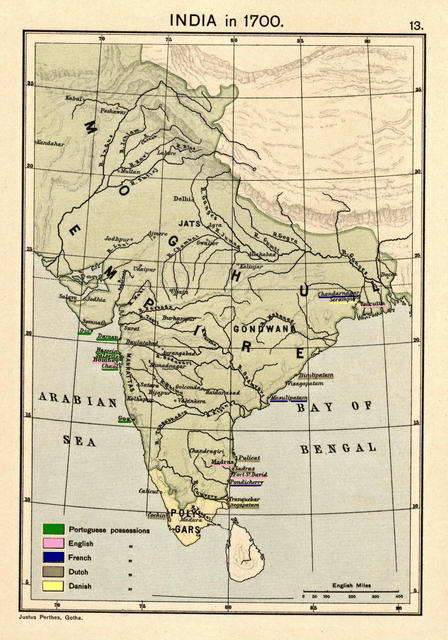
Mughal Empire

Mughal Empire | |||||||||||||||||||||||||||
|---|---|---|---|---|---|---|---|---|---|---|---|---|---|---|---|---|---|---|---|---|---|---|---|---|---|---|---|
| |||||||||||||||||||||||||||
| Status | Empire | ||||||||||||||||||||||||||
| Capital | |||||||||||||||||||||||||||
| Common languages | |||||||||||||||||||||||||||
| Religion |
| ||||||||||||||||||||||||||
| Government | Absolute monarchy, unitary state with federal structure, centralized autocracy Islamic sharia[4] | ||||||||||||||||||||||||||
| Emperor[1] | |||||||||||||||||||||||||||
• 1526–1530 | Babur (first) | ||||||||||||||||||||||||||
• 1837–1857 | Bahadur Shah II (last) | ||||||||||||||||||||||||||
| Historical era | Early modern | ||||||||||||||||||||||||||
• First Battle of Panipat | 21 April 1526 | ||||||||||||||||||||||||||
• Empire interrupted by Sur Empire | 1540–1555 | ||||||||||||||||||||||||||
| 1680–1707 | |||||||||||||||||||||||||||
• Death of Aurangzeb | 3 March 1707 | ||||||||||||||||||||||||||
• Battle of Karnal | 24 February 1739 | ||||||||||||||||||||||||||
• Carnatic Wars | 1746–1763 | ||||||||||||||||||||||||||
• Battle of Plassey | 1757 | ||||||||||||||||||||||||||
• Bengal War | 1759–1765 | ||||||||||||||||||||||||||
• Siege of Delhi | 21 September 1857 | ||||||||||||||||||||||||||
| Area | |||||||||||||||||||||||||||
| 1690[6][7] | 4,000,000 km2(1,500,000 sq mi) | ||||||||||||||||||||||||||
| Population | |||||||||||||||||||||||||||
• 1700[8] | 158,400,000 | ||||||||||||||||||||||||||
| Currency | Rupee, Taka, dam[9]:73–74 | ||||||||||||||||||||||||||
| |||||||||||||||||||||||||||
The Mughal (or Moghul) Empire was an early-modern empire in South Asia.[10] For some two centuries, the empire stretched from the outer fringes of the Indus basin in the west, northern Afghanistan in the northwest, and Kashmir in the north, to the highlands of present-day Assam and Bangladesh in the east, and the uplands of the Deccan plateau in South India.[11] At its greatest extent, it was one of the largest empires in the history of South Asia.[12]
The Mughal Empire is conventionally said to have been founded in 1526 by Babur, a warrior chieftain from what today is Uzbekistan, who employed aid from the neighboring Safavid and Ottoman empires[13] to defeat the Sultan of Delhi, Ibrahim Lodhi, in the First Battle of Panipat, and to sweep down the plains of Upper India. The Mughal imperial structure, however, is sometimes dated to 1600, to the rule of Babur's grandson, Akbar.[14] This imperial structure lasted until 1720, until shortly after the death of the last major emperor, Aurengzeb,[15][16] during whose reign the empire also achieved its maximum geographical extent. The empire subsequently fragmented, reduced to the region in and around Old Delhi by the time the British East India Company came to rule most of India. The empire was formally dissolved by the British Raj after the Indian Rebellion of 1857.
Although the Mughal Empire was created and sustained by military warfare,[17][18][19] it did not vigorously suppress the cultures and peoples it came to rule, but rather equalized and placated them through new administrative practices,[20][21] and diverse ruling elites, leading to more efficient, centralised, and standardized rule.[22] The relative peace maintained by the empire during much of the 17th century was a factor in India's economic expansion.[23] The main base of the empire's collective wealth was agricultural taxes, instituted by the third Mughal emperor, Akbar.[24][25] Mughal India was also the world leader in manufacturing,[26] producing about 25% of the world's industrial output up until the 18th century.[27] Burgeoning European presence in the Indian Ocean, and its increasing demand for Indian raw and finished products, created still greater wealth in the Mughal courts.[28]
There was more conspicuous consumption among the Mughal elite,[29] resulting in greater patronage of painting, literary forms, textiles, and architecture, especially during the reign of Shah Jahan.[30] Among the Mughal UNESCO World Heritage Sites in South Asia are: Agra Fort, Fatehpur Sikri, Red Fort, Humayun's Tomb, Lahore Fort and the Taj Mahal, which is described as, "The jewel of Muslim art in India, and one of the universally admired masterpieces of the world's heritage."[31]
Mughal Empire | |||||||||||||||||||||||||||
|---|---|---|---|---|---|---|---|---|---|---|---|---|---|---|---|---|---|---|---|---|---|---|---|---|---|---|---|
| |||||||||||||||||||||||||||
| Status | Empire | ||||||||||||||||||||||||||
| Capital | |||||||||||||||||||||||||||
| Common languages | |||||||||||||||||||||||||||
| Religion |
| ||||||||||||||||||||||||||
| Government | Absolute monarchy, unitary state with federal structure, centralized autocracy Islamic sharia[4] | ||||||||||||||||||||||||||
| Emperor[1] | |||||||||||||||||||||||||||
• 1526–1530 | Babur (first) | ||||||||||||||||||||||||||
• 1837–1857 | Bahadur Shah II (last) | ||||||||||||||||||||||||||
| Historical era | Early modern | ||||||||||||||||||||||||||
• First Battle of Panipat | 21 April 1526 | ||||||||||||||||||||||||||
• Empire interrupted by Sur Empire | 1540–1555 | ||||||||||||||||||||||||||
| 1680–1707 | |||||||||||||||||||||||||||
• Death of Aurangzeb | 3 March 1707 | ||||||||||||||||||||||||||
• Battle of Karnal | 24 February 1739 | ||||||||||||||||||||||||||
• Carnatic Wars | 1746–1763 | ||||||||||||||||||||||||||
• Battle of Plassey | 1757 | ||||||||||||||||||||||||||
• Bengal War | 1759–1765 | ||||||||||||||||||||||||||
• Siege of Delhi | 21 September 1857 | ||||||||||||||||||||||||||
| Area | |||||||||||||||||||||||||||
| 1690[6][7] | 4,000,000 km2(1,500,000 sq mi) | ||||||||||||||||||||||||||
| Population | |||||||||||||||||||||||||||
• 1700[8] | 158,400,000 | ||||||||||||||||||||||||||
| Currency | Rupee, Taka, dam[9]:73–74 | ||||||||||||||||||||||||||
| |||||||||||||||||||||||||||
Name
The Mughal designation for their own dynasty was Gurkani (Persian: گورکانیان, Gūrkāniyān, meaning "sons-in-law").[34] The use of "Mughal" derived from the Arabic and Persian corruption of "Mongol", and it emphasised the Mongol origins of the Timurid dynasty.[35] The term gained currency during the 19th century, but remains disputed by Indologists.[36] Similar terms had been used to refer to the empire, including "Mogul" and "Moghul".[37][38] Nevertheless, Babur's ancestors were sharply distinguished from the classical Mongols insofar as they were oriented towards Persian rather than Turco-Mongol culture.[39]
History
Babur and Humayun (1526–1556)
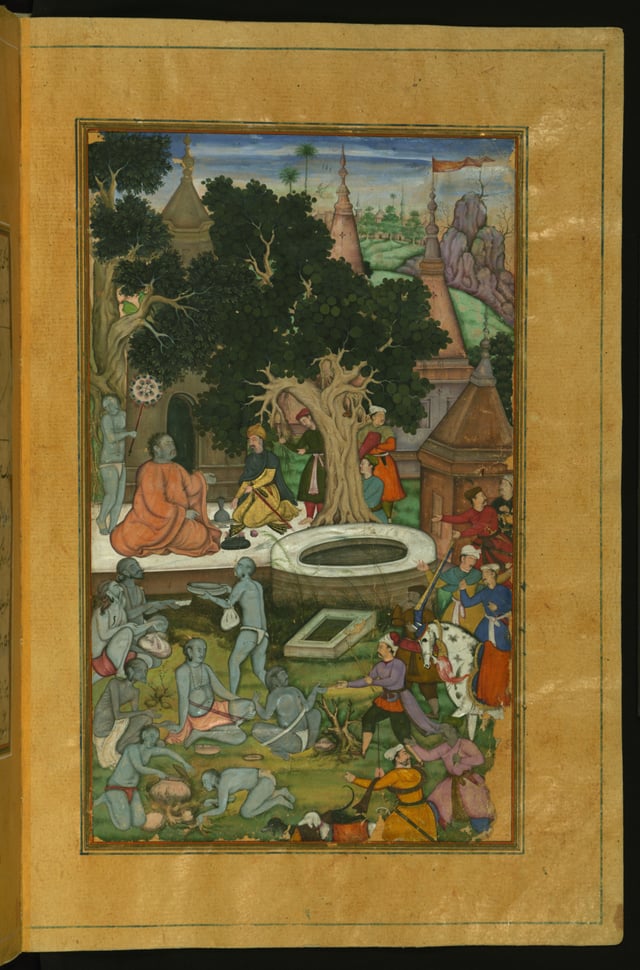
Babur, the founder of the Mughal Empire, and his warriors visiting a Hindu temple in the Indian subcontinent.
The Mughal Empire was founded by Babur (reigned 1526–1530), a Central Asian ruler who was descended from the Turco-Mongol conqueror Timur (the founder of the Timurid Empire) on his father's side, and from Genghis Khan on his mother's side.[42] Ousted from his ancestral domains in Central Asia, Babur turned to India to satisfy his ambitions.[43] He established himself in Kabul and then pushed steadily southward into India from Afghanistan through the Khyber Pass.[42] Babur's forces occupied much of northern India after his victory at Panipat in 1526.[42] The preoccupation with wars and military campaigns, however, did not allow the new emperor to consolidate the gains he had made in India.[44]
The instability of the empire became evident under his son, Humayun (reigned 1530–1556), who was forced into exile in Persia by rebels. The Sur Empire (1540–1555), founded by Sher Shah Suri (reigned 1540–1545), briefly interrupted Mughal rule.[42] Humayun's exile in Persia established diplomatic ties between the Safavid and Mughal Courts, and led to increasing Persian cultural influence in the Mughal Empire. Humayun's triumphant return from Persia in 1555 restored Mughal rule, but he died in an accident the next year.[42]
Akbar to Aurangzeb (1556–1707)
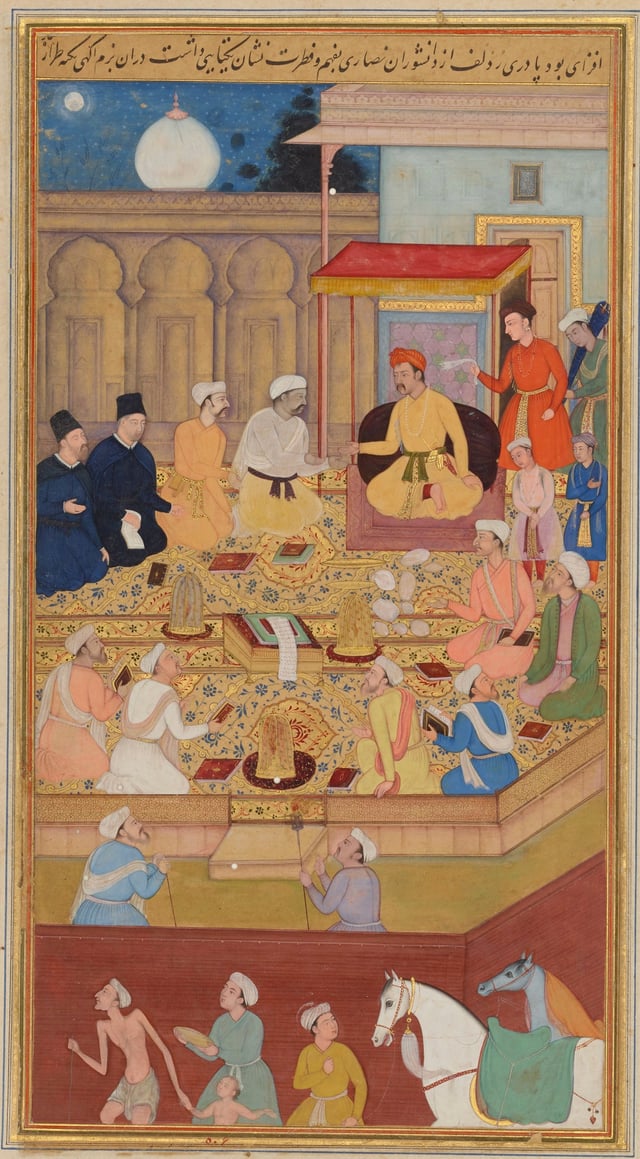
Akbar holds a religious assembly of different faiths in the Ibadat Khana in Fatehpur Sikri.
Akbar (reigned 1556–1605) was born Jalal-ud-din Muhammad[45] in the Rajput Umarkot Fort,[46] to Humayun and his wife Hamida Banu Begum, a Persian princess.[47] Akbar succeeded to the throne under a regent, Bairam Khan, who helped consolidate the Mughal Empire in India. Through warfare and diplomacy, Akbar was able to extend the empire in all directions and controlled almost the entire Indian subcontinent north of the Godavari River. He created a new ruling elite loyal to him, implemented a modern administration, and encouraged cultural developments. He increased trade with European trading companies.[42] India developed a strong and stable economy, leading to commercial expansion and economic development. Akbar allowed freedom of religion at his court, and attempted to resolve socio-political and cultural differences in his empire by establishing a new religion, Din-i-Ilahi, with strong characteristics of a ruler cult.[42] He left his son an internally stable state, which was in the midst of its golden age, but before long signs of political weakness would emerge.[42]
Jahangir (born Salim,[48] reigned 1605–1627) was born to Akbar and his wife Mariam-uz-Zamani, an Indian Rajput princess.[49] He "was addicted to opium, neglected the affairs of the state, and came under the influence of rival court cliques".[42] Shah Jahan (reigned 1628–1658) was born to Jahangir and his wife Jagat Gosaini, a Rajput princess.[48] During the reign of Shah Jahan, the splendour of the Mughal court reached its peak, as exemplified by the Taj Mahal. The cost of maintaining the court, however, began to exceed the revenue coming in.[42]
Shah Jahan's eldest son, the liberal Dara Shikoh, became regent in 1658, as a result of his father's illness. Dara championed a syncretistic Hindu-Muslim culture. With the support of the Islamic orthodoxy, however, a younger son of Shah Jahan, Aurangzeb (reigned 1658–1707), seized the throne. Aurangzeb defeated Dara in 1659 and had him executed.[42] Although Shah Jahan fully recovered from his illness, Aurangzeb declared him incompetent to rule and had him imprisoned. During Aurangzeb's reign, the empire gained political strength once more and became the world's most powerful economy. Aurangzeb fully established sharia by compiling the Fatwa Alamgiri. He expanded the empire to include almost the whole of South Asia, but at his death in 1707, "many parts of the empire were in open revolt".[42] Aurangzeb is considered India's most controversial king,[50] with some historians arguing his religious conservatism and intolerance undermined the stability of Mughal society,[42] while other historians question this, noting that he built Hindu temples,[51] employed significantly more Hindus in his imperial bureaucracy than his predecessors did, opposed bigotry against Hindus and Shia Muslims,[50] [] and married Hindu Rajput princess Nawab Bai.[48]
Decline (1707–1857)

Emperor Shah Jahan and Prince Aurangzeb in Mughal Court, 1650
Aurangzeb's son, Bahadur Shah I, repealed the religious policies of his father, and attempted to reform the administration. "However, after his death in 1712, the Mughal dynasty sank into chaos and violent feuds. In 1719 alone, four emperors successively ascended the throne".[42]
During the reign of Muhammad Shah (reigned 1719–1748), the empire began to break up, and vast tracts of central India passed from Mughal to Maratha hands. The far-off Indian campaign of Nadir Shah, who had priorly reestablished Iranian suzerainty over most of West Asia, the Caucasus, and Central Asia, culminated with the Sack of Delhi and shattered the remnants of Mughal power and prestige. Many of the empire's elites now sought to control their own affairs, and broke away to form independent kingdoms. But, according to Sugata Bose and Ayesha Jalal, the Mughal Emperor continued to be the highest manifestation of sovereignty. Not only the Muslim gentry, but the Maratha, Hindu, and Sikh leaders took part in ceremonial acknowledgements of the emperor as the sovereign of India.[52]
Meanwhile, some regional polities within the increasingly fragmented Mughal Empire, involved themselves and the state within global conflicts, leading only to defeat and loss of territory during the Carnatic Wars and the Bengal War.
The Mughal Emperor Shah Alam II (1759–1806) made futile attempts to reverse the Mughal decline but ultimately had to seek the protection of the Emir of Afghanistan, Ahmed Shah Abdali, which led to the Third Battle of Panipat between the Maratha Empire and the Afghans led by Abdali in 1761. In 1771, the Marathas recaptured Delhi from Afghan control and in 1784 they officially became the protectors of the emperor in Delhi,[53] a state of affairs that continued further until after the Third Anglo-Maratha War. Thereafter, the British East India Company became the protectors of the Mughal dynasty in Delhi.[52] The British East India Company took control of the former Mughal province of Bengal-Bihar in 1793 after it abolished local rule (Nizamat) that lasted until 1858, marking the beginning of British colonial era over the Indian Subcontinent. By 1857 a considerable part of former Mughal India was under the East India Company's control. After a crushing defeat in the war of 1857–1858 which he nominally led, the last Mughal, Bahadur Shah Zafar, was deposed by the British East India Company and exiled in 1858. Through the Government of India Act 1858 the British Crown assumed direct control of East India Company-held territories in India in the form of the new British Raj. In 1876 the British Queen Victoria assumed the title of Empress of India.
Causes of decline
Historians have offered numerous explanations for the rapid collapse of the Mughal Empire between 1707 and 1720, after a century of growth and prosperity. In fiscal terms the throne lost the revenues needed to pay its chief officers, the emirs (nobles) and their entourages. The emperor lost authority, as the widely scattered imperial officers lost confidence in the central authorities, and made their own deals with local men of influence. The imperial army, bogged down in long, futile wars against the more aggressive Marathas, lost its fighting spirit. Finally came a series of violent political feuds over control of the throne. After the execution of emperor Farrukhsiyar in 1719, local Mughal successor states took power in region after region.[54]
Contemporary chroniclers bewailed the decay they witnessed, a theme picked up by the first British historians who wanted to underscore the need for a British-led rejuvenation.[55]
Modern views on the decline
Since the 1970s historians have taken multiple approaches to the decline, with little consensus on which factor was dominant. The psychological interpretations emphasise depravity in high places, excessive luxury, and increasingly narrow views that left the rulers unprepared for an external challenge. A Marxist school (led by Irfan Habib and based at Aligarh Muslim University) emphasises excessive exploitation of the peasantry by the rich, which stripped away the will and the means to support the regime.[56] Karen Leonard has focused on the failure of the regime to work with Hindu bankers, whose financial support was increasingly needed; the bankers then helped the Maratha and the British.[57] In a religious interpretation, some scholars argue that the Hindu powers revolted against the rule of a Muslim dynasty.[58] Finally, other scholars argue that the very prosperity of the Empire inspired the provinces to achieve a high degree of independence, thus weakening the imperial court.[59]
Jeffrey G. Williamson has argued that the Indian economy went through deindustrialization in the latter half of the 18th century as an indirect outcome of the collapse of the Mughal Empire, with British rule later causing further deindustrialization.[60] According to Williamson, the decline of the Mughal Empire led to a decline in agricultural productivity, which drove up food prices, then nominal wages, and then textile prices, which led to India losing a share of the world textile market to Britain even before it had superior factory technology.[61] Indian textiles, however, still maintained a competitive advantage over British textiles up until the 19th century.[62]
Administrative divisions
Subah (Urdu: صوبہ) was the term for a province in the Mughal Empire. The word is derived from Arabic. The governor of a Subah was known as a subahdar (sometimes also referred to as a "Subah"[63]), which later became subedar to refer to an officer in the Indian Army. The subahs were established by padshah (emperor) Akbar during his administrative reforms of 1572–1580; initially they numbered 12, but his conquests expanded the number of subahs to 15 by the end of his reign. Subahs were divided into Sarkars, or districts. Sarkars were further divided into Parganas or Mahals. His successors, most notably Aurangzeb, expanded the number of subahs further through their conquests. As the empire began to dissolve in the early 18th century, many subahs became effectively independent, or were conquered by the Marathas or the British.
The original twelve subahs created as a result of administrative reform by Akbar:
Agra Subah
Ajmer subah
Awadh Subah
Bengal Subah
Bihar Subah
Delhi Subah
Gujarat Subah
Kabul Subah
Illahabad Subah
Lahore Subah
Malwa Subah
Multan Subah
Economy
The Indian economy was large and prosperous under the Mughal Empire.[64] During the Mughal era, the gross domestic product (GDP) of India in 1600 was estimated at about 22% of the world economy, the second largest in the world, behind only Ming China but larger than Europe. By 1700, the GDP of Mughal India had risen to 24% of the world economy, the largest in the world, larger than both Qing China and Western Europe.[65] Mughal India was the world leader in manufacturing,[26] producing about 25% of the world's industrial output up until the 18th century.[27] India's GDP growth increased under the Mughal Empire, with India's GDP having a faster growth rate during the Mughal era than in the 1,500 years prior to the Mughal era.[65] Mughal India's economy has been described as a form of proto-industrialization, like that of 18th-century Western Europe prior to the Industrial Revolution.[66]
The Mughals were responsible for building an extensive road system, creating a uniform currency, and the unification of the country.[9] [] The empire had an extensive road network, which was vital to the economic infrastructure, built by a public works department set up by the Mughals which designed, constructed and maintained roads linking towns and cities across the empire, making trade easier to conduct.[64]
The main base of the empire's collective wealth was agricultural taxes, instituted by the third Mughal emperor, Akbar.[24][25] These taxes, which amounted to well over half the output of a peasant cultivator,[67] were paid in the well-regulated silver currency,[22] and caused peasants and artisans to enter larger markets.[68]
Coinage
The Mughals adopted and standardized the rupee (rupiya, or silver) and dam (copper) currencies introduced by Sur Emperor Sher Shah Suri during his brief rule.[69] The currency was initially 48 dams to a single rupee in the beginning of Akbar's reign, before it later became 38 dams to a rupee in the 1580s, with the dam's value rising further in the 17th century as a result of new industrial uses for copper, such as in bronze cannons and brass utensils. The dam was initially the most common coin in Akbar's time, before being replaced by the rupee as the most common coin in succeeding reigns.[9] The dam's value was later worth 30 to a rupee towards the end of Jahangir's reign, and then 16 to a rupee by the 1660s.[70] The Mughals minted coins with high purity, never dropping below 96%, and without debasement until the 1720s.[71]
Despite India having its own stocks of gold and silver, the Mughals produced minimal gold of their own, but mostly minted coins from imported bullion, as a result of the empire's strong export-driven economy, with global demand for Indian agricultural and industrial products drawing a steady stream of precious metals into India.[9] Around 80% of Mughal India's imports were bullion, mostly silver,[72] with major sources of imported bullion including the New World and Japan,[71] which in turn imported large quantities of textiles and silk from the Bengal Subah province.[9]
Labour
The Mughal Empire's workforce in the early 17th century consisted of about 64% in the primary sector (including agriculture), over 11% in the secondary sector (manufacturing), and about 25% in the tertiary sector (service).[73] Mughal India's workforce had a higher percentage in the non-primary sector than Europe's workforce did at the time; agriculture accounted for 65–90% of Europe's workforce in 1700, and 65–75% in 1750, including 65% of England's workforce in 1750.[74] Historian Shireen Moosvi estimates that in terms of contributions to the Mughal economy, in the late 16th century, the primary sector contributed 52%, the secondary sector 18% and the tertiary sector 29%; the secondary sector contributed a higher percentage than in early 20th-century British India, where the secondary sector only contributed 11% to the economy.[75] In terms of urban-rural divide, 18% of Mughal India's labour force were urban and 82% were rural, contributing 52% and 48% to the economy, respectively.[76]
Real wages and living standards in 18th-century Mughal Bengal and South India were higher than in Britain, which in turn had the highest living standards in Europe.[77][60] According to economic historian Paul Bairoch, India as well as China had a higher GNP per capita than Europe up until the late 18th century,[78][79] before Western European per-capita income pulled ahead after 1800.[80] According to Moosvi, Mughal India also had a per-capita income 1.24% higher in the late 16th century than British India did in the early 20th century.[81] However, in a system where wealth was hoarded by elites, wages were depressed for manual labour,[82] though no less than labour wages in Europe at the time.[77] In Mughal India, there was a generally tolerant attitude towards manual labourers, with some religious cults in northern India proudly asserting a high status for manual labour. While slavery also existed, it was limited largely to household servants.[82]
Agriculture
Indian agricultural production increased under the Mughal Empire.[64] A variety of crops were grown, including food crops such as wheat, rice, and barley, and non-food cash crops such as cotton, indigo and opium. By the mid-17th century, Indian cultivators begun to extensively grow two new crops from the Americas, maize and tobacco.[64]
The Mughal administration emphasized agrarian reform, which began under the non-Mughal emperor Sher Shah Suri, the work of which Akbar adopted and furthered with more reforms. The civil administration was organized in a hierarchical manner on the basis of merit, with promotions based on performance.[4] The Mughal government funded the building of irrigation systems across the empire, which produced much higher crop yields and increased the net revenue base, leading to increased agricultural production.[64]
A major Mughal reform introduced by Akbar was a new land revenue system called zabt. He replaced the tribute system, previously common in India and used by Tokugawa Japan at the time, with a monetary tax system based on a uniform currency.[71] The revenue system was biased in favour of higher value cash crops such as cotton, indigo, sugar cane, tree-crops, and opium, providing state incentives to grow cash crops, in addition to rising market demand.[9] Under the zabt system, the Mughals also conducted extensive cadastral surveying to assess the area of land under plow cultivation, with the Mughal state encouraging greater land cultivation by offering tax-free periods to those who brought new land under cultivation.[71] The expansion of agriculture and cultivation continued under later Mughal emperors including Aurangzeb, whose 1665 firman edict stated: "the entire elevated attention and desires of the Emperor are devoted to the increase in the population and cultivation of the Empire and the welfare of the whole peasantry and the entire people."[83]
Mughal agriculture was in some ways advanced compared to European agriculture at the time, exemplified by the common use of the seed drill among Indian peasants before its adoption in Europe.[84] While the average peasant across the world was only skilled in growing very few crops, the average Indian peasant was skilled in growing a wide variety of food and non-food crops, increasing their productivity.[85] Indian peasants were also quick to adapt to profitable new crops, such as maize and tobacco from the New World being rapidly adopted and widely cultivated across Mughal India between 1600 and 1650. Bengali farmers rapidly learned techniques of mulberry cultivation and sericulture, establishing Bengal Subah as a major silk-producing region of the world.[9] Sugar mills appeared in India shortly before the Mughal era. Evidence for the use of a draw bar for sugar-milling appears at Delhi in 1540, but may also date back earlier, and was mainly used in the northern Indian subcontinent. Geared sugar rolling mills first appeared in Mughal India, using the principle of rollers as well as worm gearing, by the 17th century.[86]
According to evidence cited by the economic historians Immanuel Wallerstein, Irfan Habib, Percival Spear, and Ashok Desai, per-capita agricultural output and standards of consumption in 17th-century Mughal India were higher than in 17th-century Europe and early 20th-century British India.[87] The increased agricultural productivity led to lower food prices. In turn, this benefited the Indian textile industry. Compared to Britain, the price of grain was about one-half in South India and one-third in Bengal, in terms of silver coinage. This resulted in lower silver coin prices for Indian textiles, giving them a price advantage in global markets.[77]
Industrial manufacturing
Up until the 18th century, Mughal India was the most important center of manufacturing in international trade.[26] Up until 1750, India produced about 25% of the world's industrial output.[60] Manufactured goods and cash crops from the Mughal Empire were sold throughout the world. Key industries included textiles, shipbuilding, and steel. Processed products included cotton textiles, yarns, thread, silk, jute products, metalware, and foods such as sugar, oils and butter.[64] The growth of manufacturing industries in the Indian subcontinent during the Mughal era in the 17th–18th centuries has been referred to as a form of proto-industrialization, similar to 18th-century Western Europe prior to the Industrial Revolution.[66]
In early modern Europe, there was significant demand for products from Mughal India, particularly cotton textiles, as well as goods such as spices, peppers, indigo, silks, and saltpeter (for use in munitions).[64] European fashion, for example, became increasingly dependent on Mughal Indian textiles and silks. From the late 17th century to the early 18th century, Mughal India accounted for 95% of British imports from Asia, and the Bengal Subah province alone accounted for 40% of Dutch imports from Asia.[88] In contrast, there was very little demand for European goods in Mughal India, which was largely self-sufficient, thus Europeans had very little to offer, except for some woolens, unprocessed metals and a few luxury items. The trade imbalance caused Europeans to export large quantities of gold and silver to Mughal India in order to pay for South Asian imports.[64] Indian goods, especially those from Bengal, were also exported in large quantities to other Asian markets, such as Indonesia and Japan.[9]
Textile industry
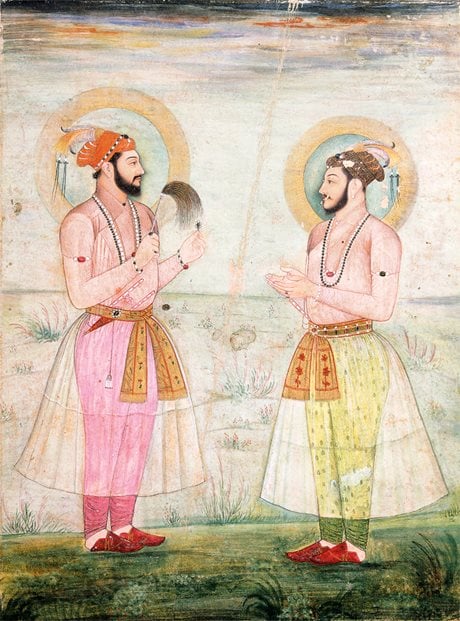
Mughal princes wearing muslin robes in 1665 CE.
The largest manufacturing industry in the Mughal Empire was textile manufacturing, particularly cotton textile manufacturing, which included the production of piece goods, calicos, and muslins, available unbleached and in a variety of colours. The cotton textile industry was responsible for a large part of the empire's international trade.[64] India had a 25% share of the global textile trade in the early 18th century.[89] Indian cotton textiles were the most important manufactured goods in world trade in the 18th century, consumed across the world from the Americas to Japan.[26] By the early 18th century, Mughal Indian textiles were clothing people across the Indian subcontinent, Southeast Asia, Europe, the Americas, Africa, and the Middle East.[61] The most important center of cotton production was the Bengal province, particularly around its capital city of Dhaka.[90]
Bengal accounted for more than 50% of textiles and around 80% of silks imported by the Dutch from Asia,[88] Bengali silk and cotton textiles were exported in large quantities to Europe, Indonesia, and Japan,[9] [] and Bengali muslin textiles from Dhaka were sold in Central Asia, where they were known as "daka" textiles.[90] Indian textiles dominated the Indian Ocean trade for centuries, were sold in the Atlantic Ocean trade, and had a 38% share of the West African trade in the early 18th century, while Indian calicos were a major force in Europe, and Indian textiles accounted for 20% of total English trade with Southern Europe in the early 18th century.[60]
The worm gear roller cotton gin, which was invented in India during the early Delhi Sultanate era of the 13th–14th centuries, came into use in the Mughal Empire some time around the 16th century,[86] and is still used in India through to the present day.[91] Another innovation, the incorporation of the crank handle in the cotton gin, first appeared in India some time during the late Delhi Sultanate or the early Mughal Empire.[92] The production of cotton, which may have largely been spun in the villages and then taken to towns in the form of yarn to be woven into cloth textiles, was advanced by the diffusion of the spinning wheel across India shortly before the Mughal era, lowering the costs of yarn and helping to increase demand for cotton. The diffusion of the spinning wheel, and the incorporation of the worm gear and crank handle into the roller cotton gin, led to greatly expanded Indian cotton textile production during the Mughal era.[93]
Shipbuilding industry
Mughal India had a large shipbuilding industry, which was also largely centered in the Bengal province. Economic historian Indrajit Ray estimates shipbuilding output of Bengal during the sixteenth and seventeenth centuries at 223,250 tons annually, compared with 23,061 tons produced in nineteen colonies in North America from 1769 to 1771.[94] He also assesses ship repairing as very advanced in Bengal.[94]
Indian shipbuilding, particularly in Bengal, was advanced compared to European shipbuilding at the time, with Indians selling ships to European firms. An important innovation in shipbuilding was the introduction of a flushed deck design in Bengal rice ships, resulting in hulls that were stronger and less prone to leak than the structurally weak hulls of traditional European ships built with a stepped deck design. The British East India Company later duplicated the flushed deck and hull designs of Bengal rice ships in the 1760s, leading to significant improvements in seaworthiness and navigation for European ships during the Industrial Revolution.[95]
Bengal Subah
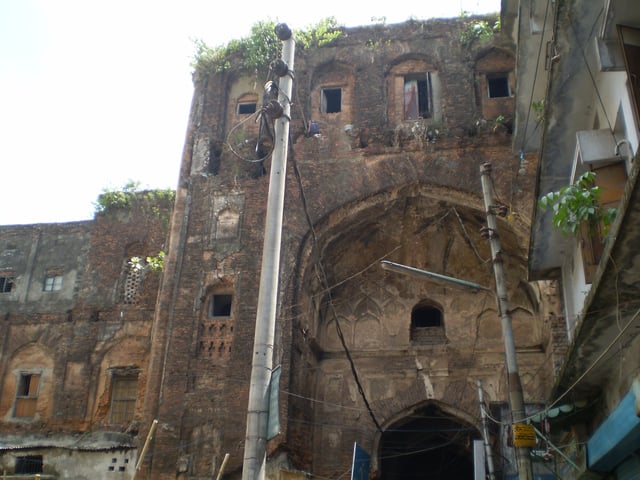
Ruins of the Great Caravanserai in Dhaka.
The Bengal Subah province was especially prosperous from the time of its takeover by the Mughals in 1590 until the British East India Company seized control in 1757.[96] It was the Mughal Empire's wealthiest province,[97] and the economic powerhouse of the Mughal Empire, estimated to have generated up to 50% of the empire's GDP.[98] Domestically, much of India depended on Bengali products such as rice, silks and cotton textiles. Overseas, Europeans depended on Bengali products such as cotton textiles, silks and opium; Bengal accounted for 40% of Dutch imports from Asia, for example, including more than 50% of textiles and around 80% of silks.[88] From Bengal, saltpeter was also shipped to Europe, opium was sold in Indonesia, raw silk was exported to Japan and the Netherlands, and cotton and silk textiles were exported to Europe, Indonesia and Japan.[9] Akbar played a key role in establishing Bengal as a leading economic centre, as he began transforming many of the jungles there into farms. As soon as he conquered the region, he brought tools and men to clear jungles in order to expand cultivation, and brought Sufis to open the jungles to farming.[83] Bengal was later described as the Paradise of Nations by Mughal emperors.[99] The Mughals introduced agrarian reforms, including the modern Bengali calendar.[100] The calendar played a vital role in developing and organising harvests, tax collection and Bengali culture in general, including the New Year and Autumn festivals. The province was a leading producer of grains, salt, fruits, liquors and wines, precious metals and ornaments.[101] Its handloom industry flourished under royal warrants, making the region a hub of the worldwide muslin trade, which peaked in the 17th and 18th centuries. The provincial capital Dhaka became the commercial capital of the empire. The Mughals expanded cultivated land in the Bengal delta under the leadership of Sufis, which consolidated the foundation of Bengali Muslim society.[102]
After 150 years of rule by Mughal viceroys, Bengal gained semi-independence as a dominion under the Nawab of Bengal in 1717. The Nawabs permitted European companies to set up trading posts across the region, including firms from Britain, France, the Netherlands, Denmark, Portugal and Austria-Hungary. An Armenian community dominated banking and shipping in major cities and towns. The Europeans regarded Bengal as the richest place for trade.[101] By the late 18th century, the British displaced the Mughal ruling class in Bengal.
Demographics
Population
India's population growth accelerated under the Mughal Empire, with an unprecedented economic and demographic upsurge which boosted the Indian population by 60%[103] to 253% in 200 years during 1500–1700.[104] The Indian population had a faster growth during the Mughal era than at any known point in Indian history prior to the Mughal era.[103][65] The increased population growth rate was stimulated by Mughal agrarian reforms that intensified agricultural production.[9] [] By the time of Aurangzeb's reign, there were a total of 455,698 villages in the Mughal Empire.[105]
The following table gives population estimates for the Mughal Empire, compared to the total population of India, including the regions of modern Pakistan and Bangladesh, and compared to the world population:
Urbanization
Cities and towns boomed under the Mughal Empire, which had a relatively high degree of urbanization for its time, with 15% of its population living in urban centres.[107] This was higher than the percentage of the urban population in contemporary Europe at the time and higher than that of British India in the 19th century;[107] the level of urbanization in Europe did not reach 15% until the 19th century.[108]
Under Akbar's reign in 1600, the Mughal Empire's urban population was up to 17 million people, 15% of the empire's total population. This was larger than the entire urban population in Europe at the time, and even a century later in 1700, the urban population of England, Scotland and Wales did not exceed 13% of its total population,[105] while British India had an urban population that was under 13% of its total population in 1800 and 9% in 1881, a decline from the earlier Mughal era.[109] By 1700, Mughal India had an urban population of 23 million people, larger than British India's urban population of 22.3 million in 1871.[110]
The historian Nizamuddin Ahmad (1551–1621) reported that, under Akbar's reign, there were 120 large cities and 3200 townships.[107] A number of cities in India had a population between a quarter-million and half-million people,[107] with larger cities including Agra (in Agra Subah) with up to 800,000 people, Lahore (in Lahore Subah) with up to 700,000 people,[111] Dhaka (in Bengal Subah) with over 1 million people,[112] and Delhi (in Delhi Subah) with over 600,000 people.[113]
Cities acted as markets for the sale of goods, and provided homes for a variety of merchants, traders, shopkeepers, artisans, moneylenders, weavers, craftspeople, officials, and religious figures.[64] However, a number of cities were military and political centres, rather than manufacturing or commerce centres.[114]
Culture
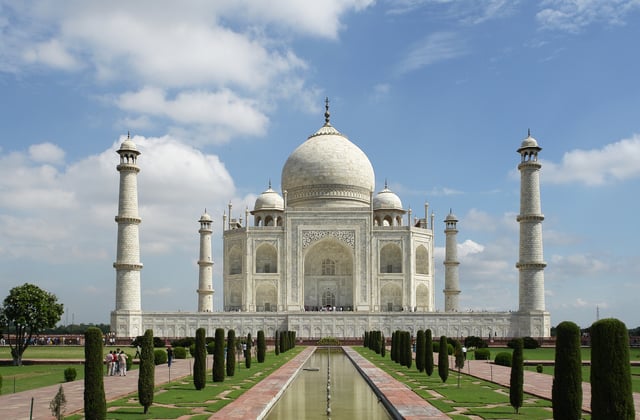
Taj Mahal in Agra, India
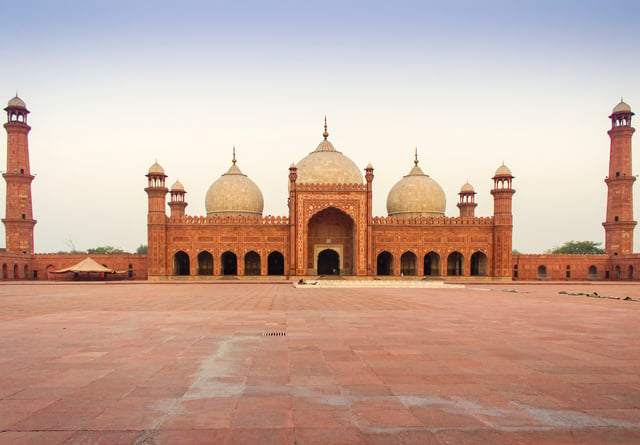
Badshahi Mosque, Lahore, Punjab, Pakistan.
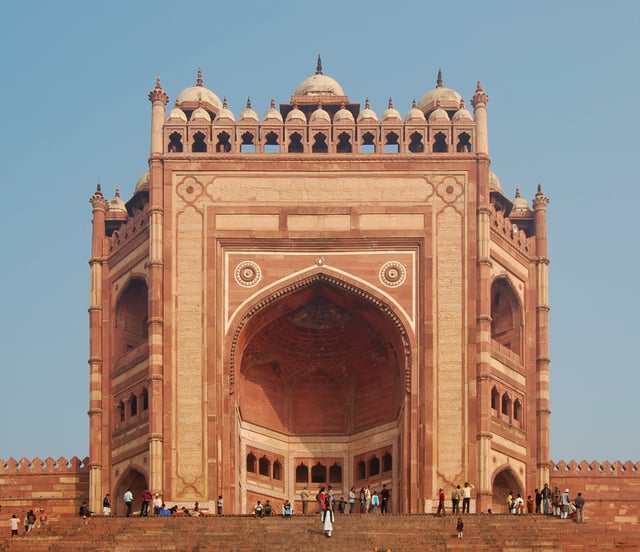
Buland Darwaza in Fatehpur Sikiri, Agra, India
The Mughal Empire was definitive in the early-modern and modern periods of South Asian history, with its legacy in India, Pakistan, Bangladesh and Afghanistan seen in cultural contributions such as:
The development of Mughlai cuisine, an amalgamation of South Asian, Iranian and Central Asian culinary styles.
The development of Mughal clothing, jewelry and fashion, utilizing richly decorated fabrics such as muslin, silk, brocade and velvet.
The standardization of the Hindustani language (the colloquial language of Bollywood), and thus the development of Hindi and Urdu.[117]
The introduction of sophisticated Iranian-style waterworks and horticulture through Mughal gardening.[118]
The introduction of Turkish baths into the Indian subcontinent.
The evolution and refinement of Mughal and Indian architecture and in turn, the development of later Rajput and Sikh palatial architecture. A famous Mughal landmark is the Taj Mahal.
The development of the Pehlwani style of Indian wrestling, a combination of Indian malla-yuddha and Persian varzesh-e bastani.[119][120]
The construction of Maktab schools, where youth were taught the Quran and Islamic law such as the Fatawa-i-Alamgiri in their indigenous languages.
The development of Hindustani classical music,[121] and instruments such as the sitar.[122]
Architecture

Verinag Gardens in Srinagar, Kashmir

Shalimar Bagh in Srinagar, Kashmir, India
The Mughals made a major contribution to the Indian subcontinent with the development of their unique Indo-Persian architecture. Many monuments were built during the Mughal era by the Muslim emperors, especially Shah Jahan, including the Taj Mahal—a UNESCO World Heritage Site considered to be "the jewel of Muslim art in India and one of the universally admired masterpieces of the world's heritage", attracting 7-8 million unique visitors a year. The palaces, tombs, gardens and forts built by the dynasty stand today in Agra, Aurangabad, Delhi, Dhaka, Fatehpur Sikri, Jaipur, Lahore, Kabul, Sheikhupura, and many other cities of India, Pakistan, Afghanistan, and Bangladesh,[123] such as:
| India | Pakistan | Bangladesh | Afghanistan |
|---|---|---|---|
|
|
|
|
Art and literature

Illustration by the 17th century Mughal artist Ustad Mansur

"Alexander Visits the Sage Plato in His Mountain Cave" illustration by the 16th century Indian artist Basawan, in a folio from a quintet of the 13th century Indian poet Amir Khusrau Dihlavi
The Mughal artistic tradition was eclectic, borrowing from Iranian, Indian and even Renaissance European stylistic and thematic elements.[124] Mughal emperors often hosted Iranian bookbinders, illustrators, painters and calligraphers from the Safavid court due to the commonalities of their Timurid styles, and due to the Mughal affinity for Iranian art and calligraphy.[125] Persian miniatures commissioned during the Mughal period focus on eventful historical or political scenes such as Iranian and Indian myths/romances, major battles, court life and marriages, but also display a profound appreciation for the serenity and beauty of the natural world.[126] For example, Emperor Jahangir commissioned brilliant artists such as Ustad Mansur to realistically portray unusual flora and fauna throughout the empire.
The literary works Jahangir ordered ranged from epics like the Razmnama (a Persian translation of the Hindu epic, the Mahabharata) to historical memoirs and recountings, including an illustrated version of the history of his reign -- Tuzuk-i Jahangiri. Richly-finished albums decorated with calligraphy and artistic scenes were mounted onto pages with decorative borders and then bound with covers of stamped and gilded or painted and lacquered leather.[127]
Language

The phrase Zuban-i Urdū-yi Muʿallá ("Language of the exalted Horde") written in Nastaʿlīq script.
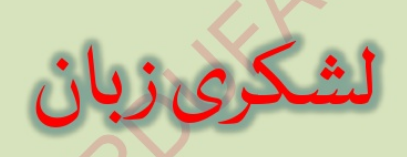
Lashkari Zabān ("military camp language" or "Hordish language") title in Nastaʿlīq script
Although Persian was the dominant and "official" language of the empire, the language of the elite was a Persianised form of Hindustani called Urdu. The language was written in a type of Perso-Arabic script known as Nastaliq, and with literary conventions and specialised vocabulary borrowed from Persian, Arabic and Turkic; the dialect was eventually given its own name of Urdu. The Mughals spoke Urdu,[128] and by the year 1700, the Mughals had formalized the language.[129] Modern Hindi, which uses Sanskrit-based vocabulary along with Perso-Arabic loan words is mutually intelligible with Urdu.
Military
Gunpowder warfare
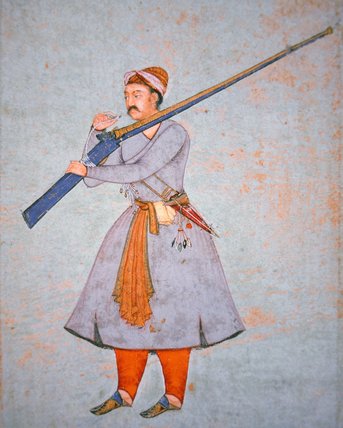
Mughal matchlock rifle, 16th century.
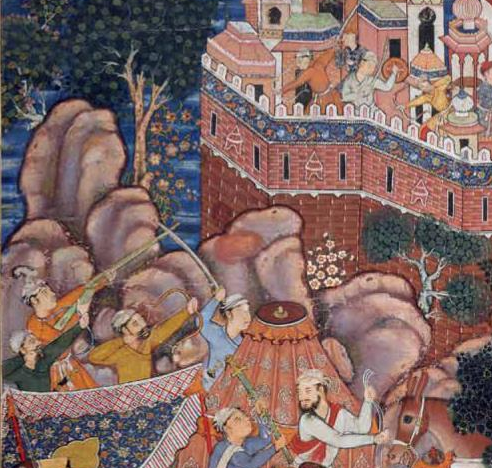
Mughal musketeer, 16th century.
Mughal India was one of the three Islamic gunpowder empires, along with the Ottoman Empire and Safavid Persia.[35][130][131] By the time he was invited by Lodi governor of Lahore, Daulat Khan, to support his rebellion against Lodi Sultan Ibrahim Khan, Babur was familiar with gunpowder firearms and field artillery, and a method for deploying them. Babur had employed Ottoman expert Ustad Ali Quli, who showed Babur the standard Ottoman formation—artillery and firearm-equipped infantry protected by wagons in the center and the mounted archers on both wings. Babur used this formation at the First Battle of Panipat in 1526, where the Afghan and Rajput forces loyal to the Delhi Sultanate, though superior in numbers but without the gunpowder weapons, were defeated. The decisive victory of the Timurid forces is one reason opponents rarely met Mughal princes in pitched battle over the course of the empire's history.[132] In India, guns made of bronze were recovered from Calicut (1504) and Diu (1533).[133]
Fathullah Shirazi (c. 1582), a Persian polymath and mechanical engineer who worked for Akbar, developed an early multi gun shot. As opposed to the polybolos and repeating crossbows used earlier in ancient Greece and China, respectively, Shirazi's rapid-firing gun had multiple gun barrels that fired hand cannons loaded with gunpowder. It may be considered a version of a volley gun.[134]
By the 17th century, Indians were manufacturing a diverse variety of firearms; large guns in particular, became visible in Tanjore, Dacca, Bijapur and Murshidabad.[135] Gujarāt supplied Europe saltpeter for use in gunpowder warfare during the 17th century,[136] and Mughal Bengal and Mālwa also participated in saltpeter production.[136] The Dutch, French, Portuguese and English used Chāpra as a center of saltpeter refining.[137]
Rocketry and explosives
In the 16th century, Akbar was the first to initiate and use metal cylinder rockets known as bans, particularly against war elephants, during the Battle of Sanbal.[138] In 1657, the Mughal Army used rockets during the Siege of Bidar.[139] Prince Aurangzeb's forces discharged rockets and grenades while scaling the walls. Sidi Marjan was mortally wounded when a rocket struck his large gunpowder depot, and after twenty-seven days of hard fighting Bidar was captured by the victorious Mughals.[139]
In A History of Greek Fire and Gunpowder, James Riddick Partington described Indian rockets and explosive mines:[133]
The Indian war rockets were formidable weapons before such rockets were used in Europe. They had bam-boo rods, a rocket-body lashed to the rod, and iron points. They were directed at the target and fired by lighting the fuse, but the trajectory was rather erratic. The use of mines and counter-mines with explosive charges of gunpowder is mentioned for the times of Akbar and Jahāngir.
Later, the Mysorean rockets were upgraded versions of Mughal rockets used during the Siege of Jinji by the progeny of the Nawab of Arcot. Hyder Ali's father Fatah Muhammad the constable at Budikote, commanded a corps consisting of 50 rocketmen (Cushoon) for the Nawab of Arcot. Hyder Ali realised the importance of rockets and introduced advanced versions of metal cylinder rockets. These rockets turned fortunes in favour of the Sultanate of Mysore during the Second Anglo-Mysore War, particularly during the Battle of Pollilur. In turn, the Mysorean rockets were the basis for the Congreve rockets, which Britain deployed in the Napoleonic Wars against France and the War of 1812 against the United States.[140]
Science
Astronomy
While there appears to have been little concern for theoretical astronomy, Mughal astronomers made advances in observational astronomy and produced nearly a hundred Zij treatises. Humayun built a personal observatory near Delhi; Jahangir and Shah Jahan were also intending to build observatories, but were unable to do so. The astronomical instruments and observational techniques used at the Mughal observatories were mainly derived from Islamic astronomy.[141][142] In the 17th century, the Mughal Empire saw a synthesis between Islamic and Hindu astronomy, where Islamic observational instruments were combined with Hindu computational techniques.[141][142]
During the decline of the Mughal Empire, the Hindu king Jai Singh II of Amber continued the work of Mughal astronomy. In the early 18th century, he built several large observatories called Yantra Mandirs, in order to rival Ulugh Beg's Samarkand observatory, and in order to improve on the earlier Hindu computations in the Siddhantas and Islamic observations in Zij-i-Sultani. The instruments he used were influenced by Islamic astronomy, while the computational techniques were derived from Hindu astronomy.[141][142]
Chemistry
Sake Dean Mahomed had learned much of Mughal chemistry and understood the techniques used to produce various alkali and soaps to produce shampoo. He was also a notable writer who described the Mughal Emperor Shah Alam II and the cities of Allahabad and Delhi in rich detail and also made note of the glories of the Mughal Empire.
In Britain, Sake Dean Mahomed was appointed as shampooing surgeon to both Kings George IV and William IV.[143]
Metallurgy
One of the most remarkable astronomical instruments invented in Mughal India is the seamless celestial globe. It was invented in Kashmir by Ali Kashmiri ibn Luqman in 998 AH (1589–90 CE), and twenty other such globes were later produced in Lahore and Kashmir during the Mughal Empire. Before they were rediscovered in the 1980s, it was believed by modern metallurgists to be technically impossible to produce metal globes without any seams.[144]
See also
List of Mongol states
Mansabdar
Mughal (tribe)
Mughal Harem
Mughal weapons
Mughal architecture
Mughal-Mongol genealogy
Islam In South Asia
